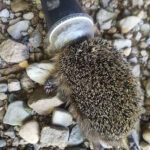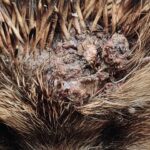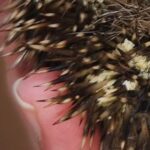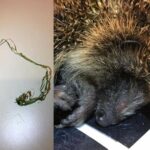Category Archives: Wildlife info
The humble hedgehog
There are some distressing photos at the end of this post - watch at readers' own discretion.
The humble hedgehog is possibly one of the main animals that come to our rescue.
Every year many, many hundreds cross our threshold and I must admit that for me they are one of the most special little creatures we have on this island we call home.
Wild at heart; it is like they know from birth where they belong. Little hoglets often huff and puff to show you how scary and dangerous they think they are and unlike many other animals, they almost never seem to like us humans, or even get used to us. Obviously, this makes helping them a little bit easier as we don’t have to worry too much about imprinting, unlike for example foxes. Saying that handling is always kept at a minimum. It is easy to forget that for the hedgehog you are a big scary predator and cuddles are stressful for them, not comforting.
Two of the most common questions we get about us and hedgehogs are:
1. Why are they brought to us and 2. Why do we bother (It’s “just a hedgehog”)
Both questions are both easy and hard to answer at the same time but here we go.
Hedgehogs are brought to us because they are in trouble and we save them because no creature deserves to suffer. That is the simple answer.
When you start to dive deeper it’s a bit more complex; what kind of trouble do they often find themselves in for example. Road traffic accidents are sadly very common and when it comes to tiny things like hedgehogs the outcome is usually instant death. In spring it’s mostly garden related injuries and these are often brutal. Strimmers cause horrific injuries to hedgehogs and often they are brought to us after flies have got to them – wounds with fly eggs and maggots are not just horrible to see but imagine the pain for the poor hog. Being eaten alive! Strimmer injuries are so easy to prevent; either don’t use strimmers at all or check the area thoroughly before using a strimmer. Remember that hogs don’t run when they are in danger, they curl up! Plus, they sleep daytime when we are more likely to do gardening.
Slug pellets are another culprit. You might think it’s just going to harm the slugs but instead, it harms anything that eats them too! Bonfires cause damage and death all year round as very few of us actually check before we light. Before you light a bonfire, you should ALWAYS move it.
Summer months bring flystrike and dehydration. Hedgehogs smell, like reaaaaaally smells and for a fly that is irresistible. Flies will lay their eggs around the skirt of the hog (the soft fur just under the last row of spines) and inside ears, around eyes, or any wounds. Contrary to popular belief a fly will not only lay eggs in wounds but on anything that smells right or provide the right habitat for the hatching maggots. In hot weather, these eggs hatch really fast and without going into too many details the hatched maggots are hungry. This is why it is SUPER important that if you find a hog in trouble, you catch it, put it somewhere safe and covered (with air holes of course), and THEN you call a rescue. Never put a source of heat with a hedgehog with flystrike, also never wash a hedgehog, ever!
Autumn brings the babies. Hedgehogs will breed till hibernation and with the seasons changing so much often they can have 2-3 litters in a year. Hibernation is triggered by cold, not a certain date of the year! We have seen some posts stating that hedgehogs outside after a certain date is automatically in trouble. This is not true. The last litter will sometimes arrive really late and the hoglets will not get enough time to put weight on to survive hibernation. These are the autumn juveniles and these are often the ones that will stay with us all through winter.
So what do you do if you find a hedgehog in need of help?
Step one is to ensure that it does need help in the first place.
A few pointers to make it easier:
1. A hedgehog will NEVER be out sunbathing. We often get phone calls about “a hedgehog that is sunbathing in my garden but it’s not moved all day”. If you see a hedgehog laying in the middle of a path or grass, get it somewhere safe asap!

Image by Alexas_Fotos from Pixabay
2. In general hedgehogs should not be out daytime, however, if the hog looks like it is going somewhere, maybe with bedding in its mouth it is probably ok, if you take it you might end up leaving some hungry hoglets abandoned in a nearby nest. If you are in doubt please ALWAYS call someone and check. Better safe than sorry!
3. If it is freezing outside or very late in the autumn, and you see a baby hedgehog out it probably needs help. Scoop it up, put it somewhere safe and warm and then call us or someone else for advice. Anything smaller than a mango is probably in need of help.
A hedgehog the size of a pineapple is probably totally fine (unless injured). Always feel free to call for advice if you are unsure!
4. A source of heat is great but only if the hedgehog does NOT have flystrike.
For a source of heat, you can use anything from a hot water bottle to an empty jam jar or bottle with hot water. Remember to not put the hedgehog on top of the source of heat but rather next to it so that it can move away if it gets too hot. Never put the hedgehog in a box with wet bedding. Just because it lives in the wild does not mean that cold, wet leaves or grass, or soaked straw is any good.
5. Last but not least: Don't keep an injured animal for a few days to see if it gets better. The majority of hedgehogs that we lose die because they are brought in too late.

Hedgehog stuck in rubbish. If you see things in nature. pick it up and dispose of it. It might not be your litter but it is our planet! Sadly this hedgehog was dead when found.

One or two ticks is not really a big deal but many could lead to problems.

Strimmer injuries are horrific and often leads to long and extreme suffering. Please check before using any gardening tools.

Flystrike looks like small grains of rice clumped together. If you see these on an animal they need help as soon as possible and should NOT be put on heat. Not to be confused with ticks.

Don't ever put flea treatment on a hedgehog without getting advice from a qualified wildlife rescue first. This hedgehog almost died after a vet practice treated it with the wrong medication. It is important to remember that most vets are specialized in domestic animals, not wildlife.

Posthole or deathtrap? We were called out to rescue little hog from this one and almost didn't manage to get him out!

Man-made materials such as garden netting might keep your plants nice and tidy but it can also cause horrible injuries to wildlife. Please keep it off the ground!